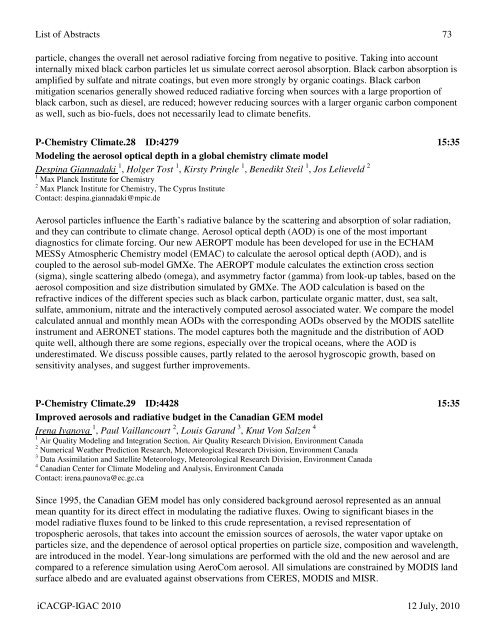Download Abstracts Here - IGAC Project
Download Abstracts Here - IGAC Project
Download Abstracts Here - IGAC Project
You also want an ePaper? Increase the reach of your titles
YUMPU automatically turns print PDFs into web optimized ePapers that Google loves.
List of <strong>Abstracts</strong> 73particle, changes the overall net aerosol radiative forcing from negative to positive. Taking into accountinternally mixed black carbon particles let us simulate correct aerosol absorption. Black carbon absorption isamplified by sulfate and nitrate coatings, but even more strongly by organic coatings. Black carbonmitigation scenarios generally showed reduced radiative forcing when sources with a large proportion ofblack carbon, such as diesel, are reduced; however reducing sources with a larger organic carbon componentas well, such as bio-fuels, does not necessarily lead to climate benefits.P-Chemistry Climate.28 ID:4279 15:35Modeling the aerosol optical depth in a global chemistry climate modelDespina Giannadaki 1 , Holger Tost 1 , Kirsty Pringle 1 , Benedikt Steil 1 , Jos Lelieveld 21 Max Planck Institute for Chemistry2 Max Planck Institute for Chemistry, The Cyprus InstituteContact: despina.giannadaki@mpic.deAerosol particles influence the Earth’s radiative balance by the scattering and absorption of solar radiation,and they can contribute to climate change. Aerosol optical depth (AOD) is one of the most importantdiagnostics for climate forcing. Our new AEROPT module has been developed for use in the ECHAMMESSy Atmospheric Chemistry model (EMAC) to calculate the aerosol optical depth (AOD), and iscoupled to the aerosol sub-model GMXe. The AEROPT module calculates the extinction cross section(sigma), single scattering albedo (omega), and asymmetry factor (gamma) from look-up tables, based on theaerosol composition and size distribution simulated by GMXe. The AOD calculation is based on therefractive indices of the different species such as black carbon, particulate organic matter, dust, sea salt,sulfate, ammonium, nitrate and the interactively computed aerosol associated water. We compare the modelcalculated annual and monthly mean AODs with the corresponding AODs observed by the MODIS satelliteinstrument and AERONET stations. The model captures both the magnitude and the distribution of AODquite well, although there are some regions, especially over the tropical oceans, where the AOD isunderestimated. We discuss possible causes, partly related to the aerosol hygroscopic growth, based onsensitivity analyses, and suggest further improvements.P-Chemistry Climate.29 ID:4428 15:35Improved aerosols and radiative budget in the Canadian GEM modelIrena Ivanova 1 , Paul Vaillancourt 2 , Louis Garand 3 , Knut Von Salzen 41 Air Quality Modeling and Integration Section, Air Quality Research Division, Environment Canada2 Numerical Weather Prediction Research, Meteorological Research Division, Environment Canada3 Data Assimilation and Satellite Meteorology, Meteorological Research Division, Environment Canada4 Canadian Center for Climate Modeling and Analysis, Environment CanadaContact: irena.paunova@ec.gc.caSince 1995, the Canadian GEM model has only considered background aerosol represented as an annualmean quantity for its direct effect in modulating the radiative fluxes. Owing to significant biases in themodel radiative fluxes found to be linked to this crude representation, a revised representation oftropospheric aerosols, that takes into account the emission sources of aerosols, the water vapor uptake onparticles size, and the dependence of aerosol optical properties on particle size, composition and wavelength,are introduced in the model. Year-long simulations are performed with the old and the new aerosol and arecompared to a reference simulation using AeroCom aerosol. All simulations are constrained by MODIS landsurface albedo and are evaluated against observations from CERES, MODIS and MISR.iCACGP-<strong>IGAC</strong> 2010 12 July, 2010








